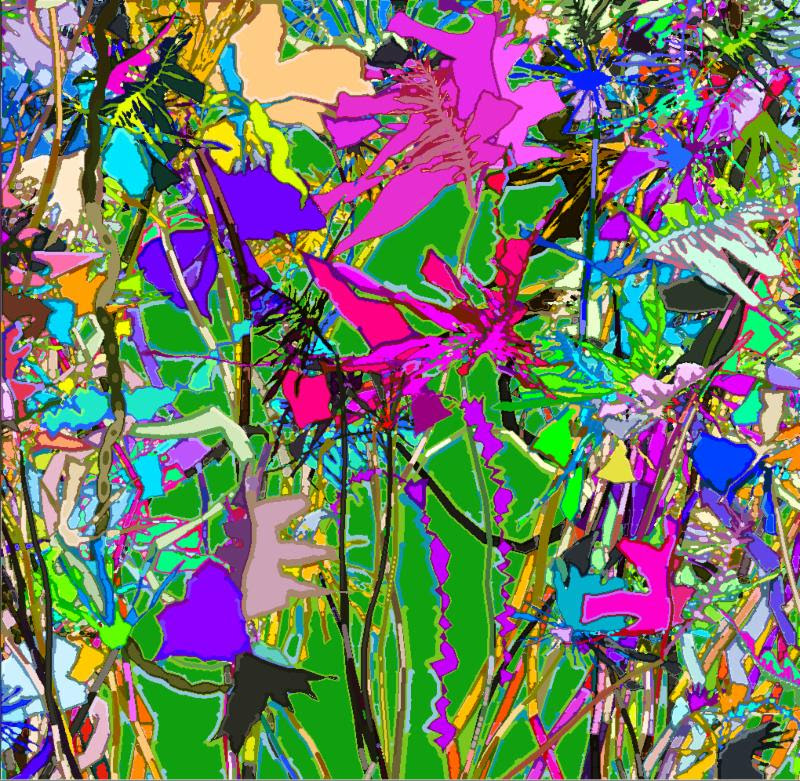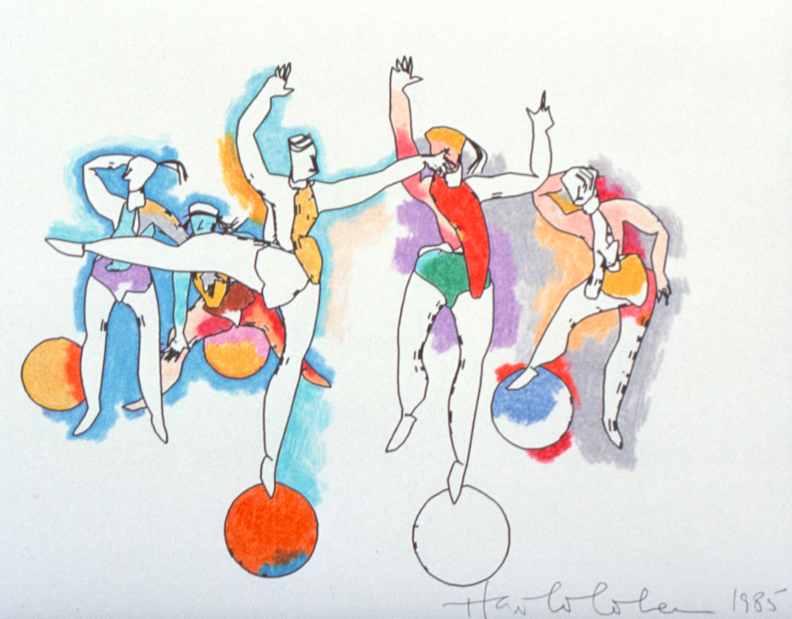Harold Cohen, Creating Computational Creativity
San Diego, Calif., Jan. 17, 2017 — An exhibit featuring the work of Harold Cohen, the founding director of the Center for Research in Computing and the Arts (CRCA), opens this week in two locations at the University of California, San Diego. CRCA was based at the UC San Diego division of the California Institute for Telecommunications and Information Technology (Calit2), also known as the Qualcomm Institute.
|
Harold Cohen, Creating Computational Creativity The UC San Diego Visual Arts Department presents an exhibition on a pioneer in computing at the arts in two locations: University Art Gallery (UAG) at Mandeville Center & Visual Arts Gallery at the Structural and Materials Engineering Building (SME) UAG: Visual Arts Gallery, SME: |
"Harold Cohen, Creating Computational Creativity" honors the memory of Professor Emeritus Harold Cohen, a pioneer in computing and the arts. Before his death in 2016, Cohen also exhibited his work at the gallery@calit2.
Cohen taught at UC San Diego from 1968 until his retirement in 1994. He arrived in San Diego with a well-established international reputation as an abstract impressionist painter, having represented Great Britain at the 33rd Venice Biennial in 1966. Once in the United States, however, he began to work with experts on artificial intelligence in Computer Science Engineering and Cognitive Science.
In 1972, he exhibited at the Los Angeles County Museum of Art a series of works generated by a computer-programmed drawing machine. He spent the next two years as a Visiting Scholar at the Artificial Intelligence Lab in the Computer Science Department at Stanford University working on a program for making art, which he later called AARON. At first, AARON produced black-and-white abstract drawings which closely resembled the drawings of Cohen himself, but AARON was continually updated and subsequently re-versioned to produce representational drawings and to work with color as well.

By the late 1970s, Cohen began to develop an international reputation for his artificial intelligence program with solo exhibitions of AARON at such important venues as the Tate Gallery in London, the Brooklyn Museum of Art in New York, the Scottish Arts Council Galleries at both Edinburgh and Aberdeen, National Museum of Wales, the Los Angeles County Museum of Art, the San Francisco Museum of Contemporary Art, and the Computer Museum in Boston.
The exhibition highlights the breadth and depth of Cohen's contributions to computing and surveys over 40 years in the development of AARON, from its inception in the early 1970s to its most recent iteration in the 2000s. The UAG exhibition features large-scale works produced by Cohen following AARON's computer-generated and enlarged designs. The SME exhibition documents AARON through photographs, texts, and video interviews, while also juxtaposing its designs with contemporary examples of computer vision and automation represented in the work of Visual Arts Professor Sheldon Brown and Robert Twomey (MFA, 2007).

When AARON was exhibited, print-out drawings were made available to gallery-goers for free or at a nominal cost. Since AARON is no longer functioning, in order to experience what it is like to interact with a computing artist program, gallery-goers are invited to explore Twomey's Convex Mirror, a contemporary computer-directed drawing machine that produces site-specific drawings to document the passage of time through changes observed in the environment. On the other hand, My Elegant Robot Freedom, designed by Brown in collaboration with Wes Hawkins in 2017, is a pneumatically-operated robot that showcases a new class of robot systems, based on addressable, interconnected membranes. This work suggests a new trajectory for art-making machines, which could be equipped with more sophisticated and flexible robotic limbs unimaginable during Cohen's early work in artificial intelligence. Nonetheless, this new technology and its artistic implications link back to Cohen's original work with the AARON program and its resulting machine-made art. Cohen's original work with art-making machines has thus anticipated the 21st-century generation of intelligent robotics.
"Harold Cohen, Creating Computational Creativity" highlights his seminal contributions to changing methods of creating art as well as to the discussion of the nature of art and the artist. Moving away from technical issues of computer-controlled fabrication, Cohen encoded in AARON his own creative dimension and particular style of drawing while also raising questions as to whether a machine can become an autonomous maker of art. AARON foreshadows in the 1970s-80s what would become important to computing in the 1990s-2000s, as particularly tied to synthetic consciousness. Essentially, Cohen's experiments in artificial intelligence (AI) challenged the idea of art as representing emotions and particular meanings by redefining it as both a representation of knowledge and a means of acquiring knowledge. In this view, Cohen situated the artist, rather than as an author of a particular creative output, as a builder of an autonomous system that could potentially produce new work after its maker has passed on.
"Harold Cohen, Creating Computational Creativity" is curated by Professor Brown and coordinated by Tatiana Sizonenko, Ph.D. '13.
Acknowledgements
Partial funding for this exhibition is generously provided by the Jacobs School of Engineering. We are particularly grateful to the Dean, Albert P. Pisano for his enthusiasm.
The Department of Visual Arts sincerely thanks Paul Cohen, Hiromi Ito, Becky Cohen, and Thomas Machnik for their enthusiasm, loan of works, and support of the project, which helped to make this exhibition a reality.
Harold Cohen, Creating Computational Creativity is the second exhibition in the series of exhibitions and events VISUAL ARTS @ 50: ART INTO LIFE, that celebrates the Department of Visual Arts' 50th anniversary in 2017. Developed by a select committee of faculty, emeriti, and alumni, the anniversary programming surveys the impact and achievements of the department and helps shape a narrative for the future of visual arts at UC San Diego.
VISUAL ARTS @ 50: ART INTO LIFE
Since its foundation in 1967, the artists, critics, theorists and historians of the Department of Visual Arts have been at the forefront of developing, studying, and promoting new and post-studio practices for art in an expanded field. Honoring the call of seminal faculty member Allan Kaprow to blur the line between art and life, VISUAL ARTS @ 50: ART INTO LIFE seeks to engage the campus and community in celebrating the illustrious history of the Department and in shaping its future.
Related Links
Media Contacts
Sheena Ghanbari
sghanbari@ucsd.edu
858-822-7755
Tiffany Fox
858) 246-0353
tfox@ucsd.edu
